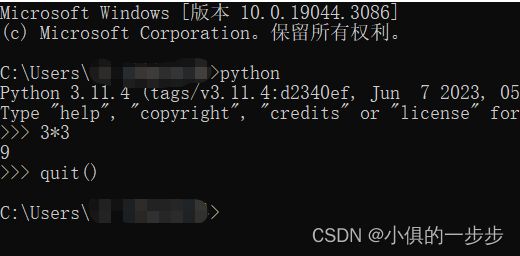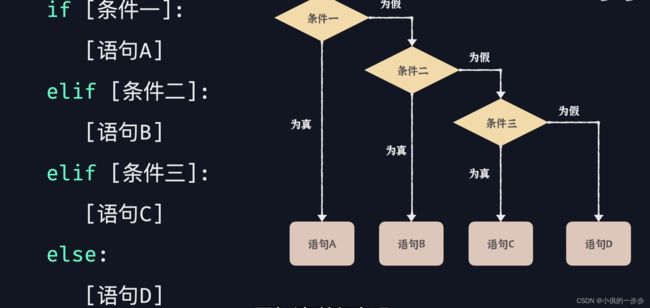有趣的Python之基本语法(一篇足够)
目录
Python简介
基本数据类型
进入交互模式
input()函数
条件语句
逻辑运算符
列表list
元组
字典
循环语句
format()方法和f
定义函数
python中的标准库引入
引入第三方库模块
面向对象
读文件
写文件
异常处理
Python简介
面向对象编程、函数式编程和过程式编程,具有丰富的第三方库,有简单易学、代码可读性高、动态类型和面向对象编程等特点。
基本数据类型
字符串(str)、整数(int)、浮点数(float)、布尔值(bool)、空值(NoneType)、元组(tuple)、列表(list)、字典(dict)和集合(set)常用的内置函数,它们被包含在Python的标准库中,可以直接使用
内置函数 — Python 3.11.4 文档
字符串的某一位:
"hello,world"[1] # e
print("123456"[-1])#6返回变量类型:
print(type("你好"))#进入交互模式
打开cmd,输入python,输入3*3, 不需要print(),就会直接显示结果,quit()将退出交互模式
input()函数
使用input()函数时,程序会暂停执行,等待用户在终端或命令行界面中输入一些文本,然后按下回车键,输入的文本会被作为字符串返回给程序。
# BMI = 体重 / (身高 ** 2)
weight = float(input("请您输入您的体重(单位:kg):"))
height= float(input("请您输入您的身高(单位:m):"))
BMI = weight/(height**2)
print("您的BMI值为:"+str(BMI))条件语句
if 条件:
结果1
else:
结果2
多条件:
逻辑运算符
and or not
优先级:not>and>or
列表list
可变,列表的元素可以为任意类型,remove(“元素”)删除某元素,
list = []
list.append("键盘")#添加
list.append("鼠标")
print(list)
list.remove("鼠标")#删除
list.append("手机")
print(list)
list[0] = "鼠标垫"#修改
print(list)
num_list = [150,500,66,870]
max_num = max(num_list)
min_num = min(num_list)
sorted_num = sorted(num_list)#排序
print(str(sorted_num)+" 中最大为 "+str(max_num)+" 最小为"+str(min_num))
输出结果:
元组
不可变数据类型,元组中的元素可以是任何类型
tuple1 = ("dg",1,22)
print(len(tuple1))
tuple1[1] = "1"#报错,'tuple' object does not support item assignment,不可变
print(tuple1)字典
键不可变,元组作可以最为键
# 字典
phone_dict = {"张三":"15299944566","王五":"19859544788"}
phone_dict["李四"] = "19659788455"
print(phone_dict)
print(len(phone_dict))返回keys()所有键,values()所有值,items()所有键值对
循环语句
1.for循环
for 变量名 in 可迭代对象:
循环体
与range()组合使用:
range(1,101)表示1到100,默认步长为1,左闭右开
total = 0
for i in range(1,101):
total = total+i
print(total)#50502.while循环
while 条件A:
行动B
format()方法和f
format()方法是一种更常用的字符串格式化方法,它接受一个或多个参数,并将它们插入到字符串中,例如:
name = 'Alice'
age = 25
print('My name is {} and I am {} years old.'.format(name, age))
#My name is Alice and I am 25 years old.f是一种格式化字符串的占位符,它可以方便地格式化字符串中的变量,例如:
name = 'Alice'
age = 25
formatted_string = f'My name is {name} and I am {age} years old.'
print(formatted_string)
#My name is Alice and I am 25 years old.定义函数
def calculate_BMI(weight,height):
BMI = weight/(height**2)
if BMI <= 18.5:
category = "偏瘦"
elif BMI <= 25:
category = "正常"
elif BMI <= 30:
category = "偏胖"
else:
category = "肥胖"
print(f"您的BMI分类为:{category}")
return BMI
BMI = calculate_BMI(70,1.8)
print(BMI)python中的标准库引入
三种方法
引入第三方库模块
由其他程序员提供, 访问网站:pypi.org
PyPI · The Python Package Index 可以搜索第三方库
安装:在终端输入: pip install + 库名
面向对象
面向对象的三大特征:封装 继承 多态
1.定义类:
创建对象并调用方法:
chen = Student("小陈","001")
chen.set_grade("数学","99")
chen.set_grade("语文","90")
chen.set_grade("英语","90")
chen.print_grades()输出结果:
2.继承:
class Cat(Animal):
def __init__(self, name):
super().__init__(name)
self.voice = "喵喵"
def print_Cat(self):
print(f"{self.name}:{self.voice}")
class Dog(Animal):
def __init__(self, name):
super().__init__(name)
self.voice = "汪汪"
def print_Dog(self):
print(f"{self.name}:{self.voice}")
cat2 = Cat("猫")
cat2.print_Cat()
dog = Dog("狗")
dog.print_Dog()
输出结果:
猫:喵喵
狗:汪汪
读文件
文件的位置:绝对路径和相对路径
绝对路径:从根目录出发
相对路径:从当前路径出发
在当前文件目录下新建data.txt文件,以下是读文件的三种例子
f = open("data.txt","r",encoding="utf-8")
print(f.read())#一一次性读完文件
print(f.read(10))#读10个字节
print(f.readline())#会读一行文件的内容
print(f.readlines())#读取文件的全部,每行为单位,返回列表
f.close()
with open("data.txt","r",encoding="utf-8") as f:#as + 文件对象的命名
lines = f.readlines()
for line in lines:
print(line)
写文件
w:清空文件,再写入
with open("data.txt","w",encoding="utf-8") as f:
f.write("我欲乘风归去,\n")
f.write("又恐琼楼玉宇,\n")
f.write("高出不胜寒。\n")
继续在data.txt文件中写
a:在文件结尾处写入
with open("data.txt","a",encoding="utf-8") as f:
f.write("起舞弄清影,\n何似在人间。")写入结果:
异常处理
try:
# 可能引发异常的代码
x = int(input("请输入一个整数:"))
except ValueError:
# 处理ValueError异常的代码
print("输入无效,请重新输入一个整数!")
except TypeError:
# 处理TypeError异常的代码
print("输入不是有效的整数!")
except ZeroDivisionError:
# 处理ZeroDivisionError异常的代码
print("无法除以零!")
else:
#无异常
print(f"{x}是一个整数")
finally:
print("无论是否出现异常都必须执行的代码")









